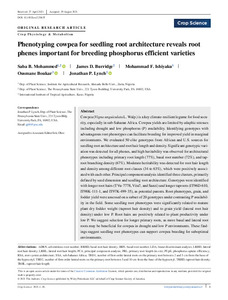| dc.contributor.author | Mohammed, S.B. |
| dc.contributor.author | Burridge, J.D. |
| dc.contributor.author | Ishiyaku, M.F. |
| dc.contributor.author | Boukar, O. |
| dc.contributor.author | Lynch, J.P. |
| dc.date.accessioned | 2022-09-29T07:22:42Z |
| dc.date.available | 2022-09-29T07:22:42Z |
| dc.date.issued | 2021 |
| dc.identifier.citation | Mohammed, S.B., Burridge, J.D., Ishiyaku, M.F., Boukar, O. & Lynch, J.P. (2021). Phenotyping cowpea for seedling root architecture reveals root phenes important for breeding phosphorus efficient varieties. Crop Science, 62(1), 326-345. |
| dc.identifier.issn | 0011-183X |
| dc.identifier.uri | https://hdl.handle.net/20.500.12478/7821 |
| dc.description.abstract | Cowpea (Vigna unguiculata L. Walp.) is a key climate-resilient legume for food security, especially in sub-Saharan Africa. Cowpea yields are limited by edaphic stresses including drought and low phosphorus (P) availability. Identifying genotypes with advantageous root phenotypes can facilitate breeding for improved yield in marginal environments. We evaluated 50 elite genotypes from African and U.S. sources for seedling root architecture and root hair length and density. Significant genotypic variation was detected for all phenes, and high heritability was observed for architectural phenotypes including primary root length (77%), basal root number (72%), and taproot branching density (67%). Moderate heritability was detected for root hair length and density among different root classes (34 to 63%), which were positively associated with each other. Principal component analysis identified three clusters, primarily defined by seed dimension and seedling root architecture. Genotypes were identified with longer root hairs (TVu-7778, Vita7, and Sanzi) and longer taproots (IT96D-610, IT98K-111-1, and IT97K-499-35), as potential parents. Root phenotypes, grain, and fodder yield were assessed on a subset of 20 genotypes under contrasting P availability in the field. Some seedling root phenotypes were significantly related to mature plant dry fodder weight (taproot hair density) and to grain yield (lateral root hair density) under low P. Root hairs are positively related to plant productivity under low P. We suggest selection for longer primary roots, as more basal and lateral root may be beneficial for cowpea in drought and low P environments. These findings suggest seedling root phenotypes can support cowpea breeding for suboptimal environments. |
| dc.description.sponsorship | United States Agency for International Development |
| dc.description.sponsorship | Bill & Melinda Gates Foundation |
| dc.description.sponsorship | United States Department of Agriculture National Institute of Food and Agriculture and Hatch Appropriations |
| dc.description.sponsorship | Howard G. Buffett Foundation |
| dc.format.extent | 326-345 |
| dc.language.iso | en |
| dc.subject | Genotypes |
| dc.subject | Phenotypes |
| dc.subject | Cowpeas |
| dc.subject | Breeding |
| dc.subject | Seedlings |
| dc.subject | Food Security |
| dc.subject | Drought |
| dc.subject | Yields |
| dc.title | Phenotyping cowpea for seedling root architecture reveals root phenes important for breeding phosphorus efficient varieties |
| dc.type | Journal Article |
| cg.contributor.crp | Agriculture for Nutrition and Health |
| cg.contributor.affiliation | Ahmadu Bello University, Nigeria |
| cg.contributor.affiliation | Pennsylvania State University, United State of America |
| cg.contributor.affiliation | International Institute of Tropical Agriculture |
| cg.coverage.region | ACP |
| cg.coverage.region | Africa |
| cg.coverage.region | Central Africa |
| cg.coverage.region | North America |
| cg.coverage.region | West Africa |
| cg.coverage.country | Burkina Faso (Upper Volta) |
| cg.coverage.country | Cameroon |
| cg.coverage.country | Ghana |
| cg.coverage.country | Nigeria |
| cg.coverage.country | Senegal |
| cg.coverage.country | United States of America |
| cg.coverage.hub | Headquarters and Western Africa Hub |
| cg.researchtheme | Biotech and Plant Breeding |
| cg.identifier.bibtexciteid | MOHAMMED:2021 |
| cg.isijournal | ISI Journal |
| cg.authorship.types | CGIAR and developing country institute |
| cg.iitasubject | Agronomy |
| cg.iitasubject | Cowpea |
| cg.iitasubject | Food Security |
| cg.iitasubject | Genetic Improvement |
| cg.iitasubject | Grain Legumes |
| cg.iitasubject | Plant Breeding |
| cg.iitasubject | Plant Genetic Resources |
| cg.iitasubject | Plant Production |
| cg.iitasubject | Soil Fertility |
| cg.journal | Crop Science |
| cg.notes | First published 15 September 2021 |
| cg.accessibilitystatus | Open Access |
| cg.reviewstatus | Internal Review |
| cg.usagerightslicense | Creative Commons Attribution 4.0 (CC BY 0.0) |
| cg.targetaudience | Scientists |
| cg.identifier.doi | https://doi.org/10.1002/csc2.20635 |
| cg.iitaauthor.identifier | 0000-0002-1796-5955 |
| cg.iitaauthor.identifier | 0000-0003-0234-4264 |
| cg.iitaauthor.identifier | 0000-0002-72659790 |
| cg.futureupdate.required | No |
| cg.identifier.issue | 1 |
| cg.identifier.volume | 62 |
| cg.contributor.acknowledgements | Saba B. Mohammed was a Fellow of the Norman E. Borlaug Leadership Enhancement in Agriculture Program funded by USAID. The support for this research was provided in part by the Borlaug Leadership Enhancement in Agriculture Program (Borlaug LEAP) through a grant to the University of California-Davis by the United States Agency for International Development. The opinions expressed herein are those of the authors and do not necessarily reflect the views of USAID. This work was also partly supported by the Bill & Melinda Gates Foundation (INV-009560) through the Program for Emerging Agricultural Research Leaders (PEARL II) Grant to the Ahmadu Bello University, Zaria-Nigeria. Research at Penn State was supported by the United States Department of Agriculture National Institute of Food and Agriculture and Hatch Appropriations (Project PEN04582), and at the field site in Arizona by a grant from the Howard G. Buffett Foundation to JPL. Authors are equally grateful to the Bao-Lam Huynh, and the Cowpea Group of the University of California-Riverside for providing seeds of some genotypes used. |

